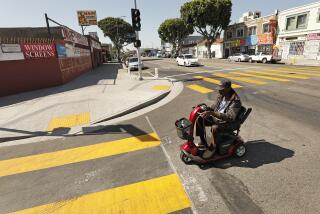Op-Ed: Cyclists don’t follow the rules of the road? Maybe it’s time to change those rules

Cyclists ride through the streets of L.A. and describe the joys and hazards of sharing the asphalt with motorists in this Los Angeles Times video.
- Share via
Like many bicycle commuters across America, Kurt Holzer looks at a stop sign and sees a suggestion rather than a command. If the intersection is clear and it’s safe to do so, he rolls right through, sometimes barely slowing down. This makes his commute just a little easier — because coming to a complete stop at intersection after intersection is a momentum killer.
In most places — including Los Angeles — Holzer’s behavior would earn him a ticket (assuming he was caught). But he lives in Boise, a city whose roads are governed by a statute known as the “Idaho stop” law. It dates back to 1982, when an Idaho magistrate judge grew weary of trivial traffic violations clogging his courtroom, and ordered a change to traffic laws that allowed cyclists to treat stop signs as yields.
A personal-injury lawyer specializing in traffic cases, Holzer recently blogged about the law, writing that in his 20 years on the job he has “never seen a car versus bike collision or a bike versus pedestrian collision that was attributable to road users following the stop-as-yield statute.”
There’s a lesson here for Los Angeles, where it seems as though motorists greet every proposal to accommodate bikes with shouts that cyclists don’t deserve anything because they don’t follow the rules of the road.
It’s true that Los Angeles is finally taking its first serious steps toward making the city more bike-friendly. But the focus is on building bike-dedicated infrastructure, which can be slow and expensive to build.
The Idaho stop law shows there are other ways for municipalities to encourage cycling while their infrastructure catches up. Cities around the world are demonstrating that simply changing the rules in favor of cyclists can make roads more welcoming.
Paris, for example, recently took the Idaho stop law even further, allowing cyclists to treat some red lights as yields. The law not only gives cyclists a leg up on cars, but sanctions behavior cyclists already employ to efficiently navigate the city.
In the Canadian province of Quebec, certain jurisdictions may loosen requirements for cyclists to always stay to the right, allowing them to ride in the middle on some roads. Officials are also debating whether to allow cyclists to split the right-hand lane to pass cars stopped in traffic, a practice that already happens every day.
Making streets more welcoming for people on bikes isn’t just a matter of easing restrictions on cyclists. After decades of car dominance, some cities are effectively cracking down on motorists, adopting rules to create a better balance of power between motor vehicles and bicycles.
Quebec recently increased fines for motorists who open their doors into passing cyclists. Laws requiring motorists to keep a minimum distance from cyclists while passing are now commonplace, including in California, and are starting to be enforced more consistently.
Some European countries, such as Denmark and the Netherlands, have restructured their liability laws to hold motorists responsible in most collisions with cyclists. The law places responsibility for safety on the more dangerous road user.
Such laws may seem politically unfeasible in a jurisdiction such as L.A. — and across California — where an abstract notion of equity between cyclists and motorists, rather than public safety, seems to guide the debate over road usage. Indeed, San Francisco’s mayor last year vetoed the adoption of the Idaho stop law because he said it “does not promote balanced public safety for all the diverse users of our streets.”
Yet streets are already governed by different rules for different users, such as laws that require slower speed limits for big trucks, or that mandate school buses to stop at uncontrolled railway crossings. Rather than demonize cyclists for their inability to conform to rules designed for cars, laws should recognize that riding a bike is different than driving.
Legislative changes to accommodate cycling often legalize practices that already exist. Beyond that, they enshrine into the rules of the road the growing understanding of the benefits that cycling brings to our city streets.
Tom Babin is the author of “Frostbike: The Joy, Pain and Numbness of Winter Cycling.” He blogs about bikes at shifter.info.
Follow the Opinion section on Twitter @latimesopinion and Facebook
MORE FROM LIVABLE CITY
Despite the controversy, Silver Lake’s ‘road diet’ worked
California is backsliding on water conservation. L.A. can’t and won’t follow suit
More to Read
A cure for the common opinion
Get thought-provoking perspectives with our weekly newsletter.
You may occasionally receive promotional content from the Los Angeles Times.










